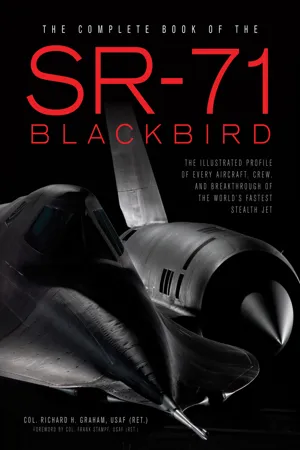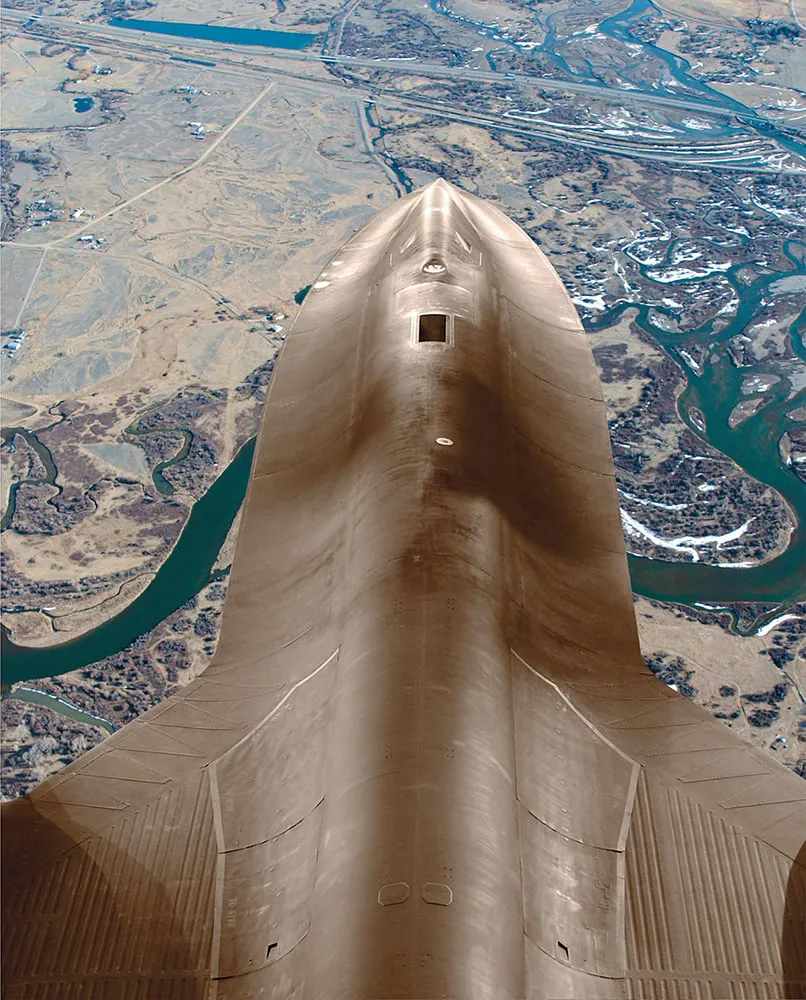09
SR-71 OPERATIONS
AT DET 1, KADENA AB, OKINAWA, JAPAN
Just as the A-12 was about to be declared operationally ready, US policy makers decided to replace it with the Air Force’s SR-71. At the time, Okinawa provided a well-suited location to fly sorties into Vietnam and also to cover other areas of interest in the Pacific theater. Kadena had the support facilities, security, and room for construction that many locations in the Pacific did not have. Facilities already built with CIA funds for the A-12 in 1965 included four large T-hangars, an adjoining maintenance complex, and living quarters for personnel. It made logistical sense to continue flying SR-71 sorties from Kadena.
The Blackbird earns its name in this fantastic top-down shot. Shutterstock
Each aircraft at Det 1 was adorned with a Habu snake on the fuselage to indicate each operational sortie flown. It was soon obvious that the number of sorties would fill the fuselage, and the tradition ceased. Richard Graham
Okinawa men drank Habu Sake, seen here for sale, in the bottles. It was reported to increase their virility! The venom from the Habu snake is high in toxicity, yet the fatality rate is less than 1 percent. A bite from a Habu snake can cause nausea, vomiting, hypotension, and possibly death. Richard Graham
The very first SR-71 operational sortie was flown at Det 1 on March 21, 1968, by Maj. Jerry O’Malley and RSO Capt. Ed Payne. Originally the detachment was called OL-8 (Operating Location-8), then changed in 1970 to OL-RK (Operating Location-Ryukyu-the Japanese island chain including Okinawa), and finally in August 1974 was called Detachment 1. Originally, only three SR-71s were kept at Det 1, but the number increased to four in the spring of 1970 due to increased intelligence requirements. Eventually, three SR-71s and a minimum of five KC-135Qs and the tanker crews were TDY to Kadena to support the operation.
When the first Blackbird arrived on the island, Okinawan residents pointed to the aircraft flying around the island and shouted, “Habu, Habu!” It reminded them of the indigenous black snake on Okinawa of the same name. Thus, the SR-71 became affectionately nicknamed “Habu” (haw-boo) by those who flew and those closely associated with the program. Crews were likewise called “Habus.” Although the SR-71 was never officially named by the Air Force, it was popularly known among worldwide aviation circles as the Blackbird. When the U-2 program moved up to Beale in 1975, there was the expected friendly rivalry between the two squadrons. The U-2 pilots didn’t like calling the SR-71 by its proper nickname, so they came up with a derogatory name of their own, calling it the “Sled.” Being called a sled driver at the Officer’s Club bar usually brought on some disparaging remarks about the U-2!
The entire Det was enclosed by a perimeter security system with a single entry point guard shack. At the main entrance, you had to show the guard your security badges to drive into the Det parking area, had to know the cipher code to open the front door of the Det, then enter the cipher code to enter operations, and finally, the combination codes to open your safe for access to the mission materials. More numbers to remember!
Early on, Det 1 consisted of a Permanent Change of Station (PCS) commander and a few other key military personnel. Everyone else was TDY from Beale and flew to and from Okinawa on the KC-135Q tankers. During the late 1970s, the entire Det shifted to PCS personnel, including their families. Moving to a PCS operation greatly increased the responsibility for the commander but also increased the efficiency and effectiveness of the Det operations. After that major reorganizational change, the only personnel going TDY to Okinawa were the tanker crews, SR-71 crews, and PSD technicians. At its peak, the total Det manpower was around 230 men and women.
The position of Det commander was always filled by former SR-71 crewmembers (one exception) who had made it up through the ranks to lieutenant colonel or colonel. Although the position was a non-flying job, it was highly sought after because the location was good, the operational missions great, and level of responsibility high. Every Det commander was given the freedom to run his operation as he saw fit and reported to no one other than the 9th Wing Commander back at Beale. It was an autonomous unit, streamlined to accomplish the operational missions and unimpeded by the bureaucracy of a large wing structure. Each Det commander was responsible for getting the mission accomplished safely.
Det 1 Routine
There was no such thing as a typical work schedule for crewmembers, because the flying activity changed from week to week. The Det was on contract with SRC to fly so many operational missions each month—typically ten to twelve per month. If we aborted a mission, flying activity had to pick up to cover the reconnaissance targets missed. To keep from flying a predictable schedule, however, sorties were randomly spaced throughout the month.
On October 26, 1987, aircraft 967 and the crew of pilot Mac McKendree and RSO Randy Shelhorse prepare for takeoff at the engine run-up area on a long 10.8-hour mission into the Persian Gulf and back. In the foreground, maintenance technicians top off the liquid-nitrogen Dewars in the nose wheelwell to ensure there is sufficient nitrogen for the trip. Mac McKendree
Two SR-71s seldom flew at the same time. Posing after flying at Det 1 is (back row L-R) Don Emmons, B. C. Thomas, and myself. In the front row (L-R) is John Murphy, Jay Reed, and Buz Carpenter. Richard Graham
Here’s a rare and unique photo of all the aircraft varieties that were based on Kadena AB in the 1980s. The SR-71 is the lead display behind all the personnel associated with each aircraft. USAF
Frank Stampf (left) and Gil Bertelson hold up a sign for the first operational mission of Jerry Glasser and Mack Hornbaker as they taxi into the hangar. It reads, “Once New Guys, Always New Guys!” Richard Graham
Four crewmembers push one of our personal cars that died. It was nice to have our own cars, but they were very unpredictable! Richard Graham
In the operations room, Buz Carpenter, Joe Kinego, and Roger Jacks wait for the mission briefing to start. Richard Graham
Three SR-71 crews were at Kadena all the time. One crew was the primary crew for a given day, another crew was the backup and also performed mobile duties, while the third crew took care of any additional duties or had the day off. The flying “ladder,” as we called it, rotated so that the next scheduled sortie had the previous mobile crew moving up the ladder as the primary fliers, the “off” crew moving up as mobile, and the previous fliers became the “off” crew. Regardless of what mission came up next, we adhered to the flying ladder religiously. Often this would make some crews envious of those fortunate enough to fly a special mission that seldom occurred.
On average we had about three missions per week. With weather cancellation, maintenance aborts, spared sorties requiring two aircraft, and everything else imaginable, you rarely saw a typical week of flying. Thrown into the weekly schedule were all the tours and briefings we gave for public relations (or out of necessity), and soon the week became full of activities. The name of the game at our Dets was to “work hard and play hard.” A classic tale by Col. Roger Jacks (Ret) emphasizes the point:
The camaraderie and team spirit was unmatched when compared to any other flying experience. SR-71 aircrews, maintenance personnel, KC-135Q aircrews, mission planners, administration personnel, and Recce Tech squadron personnel worked hard and played hard at our detachments. I recall a mission that, according to the intelligence shop, was going to be especially hazardous since it had been reported the “bad guys” were out to shoot down an SR-71. Everyone seemed to sense the potential for danger, and the resolve to successfully pull off this mission became intense. As we were cleared to taxi onto the runway and hold, my pilot, Maj. Joe Kinego, said, “Look out the right side of the aircraft—you won’t believe it.” When I looked out the aircraft, I saw our maintenance crews all lined up down the right side of the runway saluting the aircraft. With a lump in our throats and pride in our hearts, we launched out on the mission. Upon returning, the maintenance crew...









